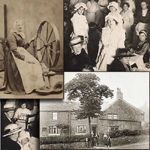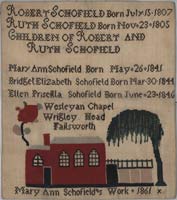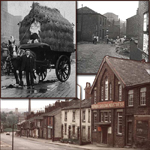
OUR MEMORIES & STORIES Wrigley Head Chapel - The Plaque The two cottages, 'Failswprth View' on Oldham Road in Failsworth, were built in 1840 by Flossie's great-grandfather, Robert Schofield, and five generations of the family have lived there. "Did you know that John Wesley came to Failsworth?" asked Michael, one day. "Yes," I replied. "How did you get to know?" "I've read about it on a wall at the bottom of Evening Street." "I can tell you something about that building and how the plaque came to be there; that is, of course, if you want to hear it." "Oh, yes, please." That plaque hasn't been there a great length of time, actually it was erected in 1970 but it so happened during the period when Joanna Leech was a scholar in the Junior Department of our Sunday School and she became very interested in the stories |
||
she was told about the Wesley family. Her parents were in the habit of taking her around into different towns when on holiday or just sight-seeing in Manchester. After seeing so many buildings about the country that the Wesleys had visited Joanna realised what an interesting story she had been able to piece together from these. Further, because she already knew that John Wesley had actually been to Failsworth, she asked why hadn't Failsworth its own sign like all the rest. Fair enough, it was a very sensible question to ask and Joanna asked it in the Sunday School where there were people willing to see just what could be done. As you know only too well, young people want things to happen very quickly and quite a lot of enthusiasm was aroused. We got a small group of people together and, as we proceeded with our enquiries, step by step, we told the children what was happening and how the people we had approached were most co-operative and how they thought it was a good idea. But you couldn't go attaching a notice to a wall just as the thought hit you. One had to get permission from the owner of the building and, fortunately in this case, he was quite willing to permit the plaque to be put on his wall. The Minister and leaders of the church also had to be informed and when the plaque was bought and fixed we had a splendid procession from the school, headed by the Scout band, with civic dignitaries, District church officials, officers of the church with members and friends including the Chairman. Joanna unveiled the plaque; there were speeches, then back into a procession and off to the school for tea and more speeches. All this happened at a very special weekend - May 24th, Wesley Day, and this unveiling took place the day before. It must have been a memorable time for Joanna because during the preceeding week she had been to Cornwall with her Mother and Father and her brother Howard and they had seen a great deal of preparation amongst the Methodists in that part of the country. You see, John Wesley, did a great deal of preaching amongst the miners in Cornwall when he was going about the country on horseback and many people still celebrate Wesley Day each year. It was fitting, therefore, that the family should see all the excitement of a Cornish celebration and then, on coming home, take part in this important event in the neighbourhood of their own place of worship. It is nice to have something like this happen to you, especially when you are young! I had, however, to explain that the Chapel Works as the building is still called, bears no resemblance, now, to the original chapel which was commenced in 1785 and opened by John Wesley in 1786. That was distinctly located on Wrigley Head and had a long garden in front. As time has advanced, cottages with loom houses, were erected where the garden had been, leaving the chapel itself, isolated. Subsequent industrial owners have re-organised the plan of the building so the front entrance to the works is now in Evening Street. Any reference, these days, to the Wrigley Head Chapel has no significance whatsoever to people who have not followed its history. Through that building, however, came people who had as astonishing affect on the district. In the first case, Wrigley Head Green in the 18th century was a hotbed of lawlessness. The unsold surpluses from the Manchester Saturday Markets found their way to Wrigley Head for a Sunday morning's market. It was to this spot that John Wesley brought his ministry of practical religion which was appropriate to the needs of the populace at that time. His powers of organisation were effective; the clean up process worked with the help of the members who had joined this new church. The people were poor enough but those who had given their allegiance to this new movement had an uplift in their thinking and although struggling to emulate the standard of their founder they managed to raise the standard of religious life. They had other aspirations, too, which were not all monetary and spiritual, and records show how they attempted to meet in the building during the week for a choral society; to create a conversation club; to form a sick society and a burial society. Things did not proceed easily for these new converts. They had much ridicule and they suffered hostility during their struggles; they had internal contentions and breakaways but still they persevered. The membership grew and a new church was built on Oldham Road in 1867. The introduction of the 1870 Education Act created a revolution in the life-styles of the people in the district. Officers of the church took on duties concerning the management of the Day School where a Government Grant had to be administered. Teachers were appointed. The first Headmistress was Miss M. Hoyle. She was referred to as a strong disciplinarian. Many of the old people I knew would talk about their schooldays and the training they received from the old Wesleyan Day School. Her struggles to impart knowledge to them might not have been appreciated at the time but they knew their lives had been fuller. Contributed by Sheila Goodyear |
||



